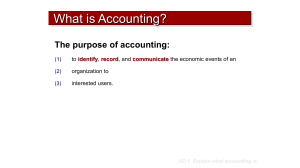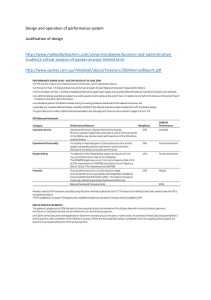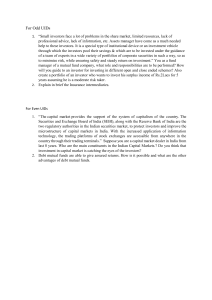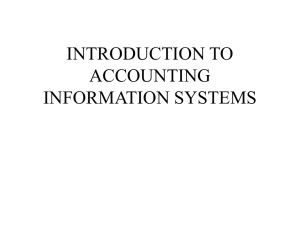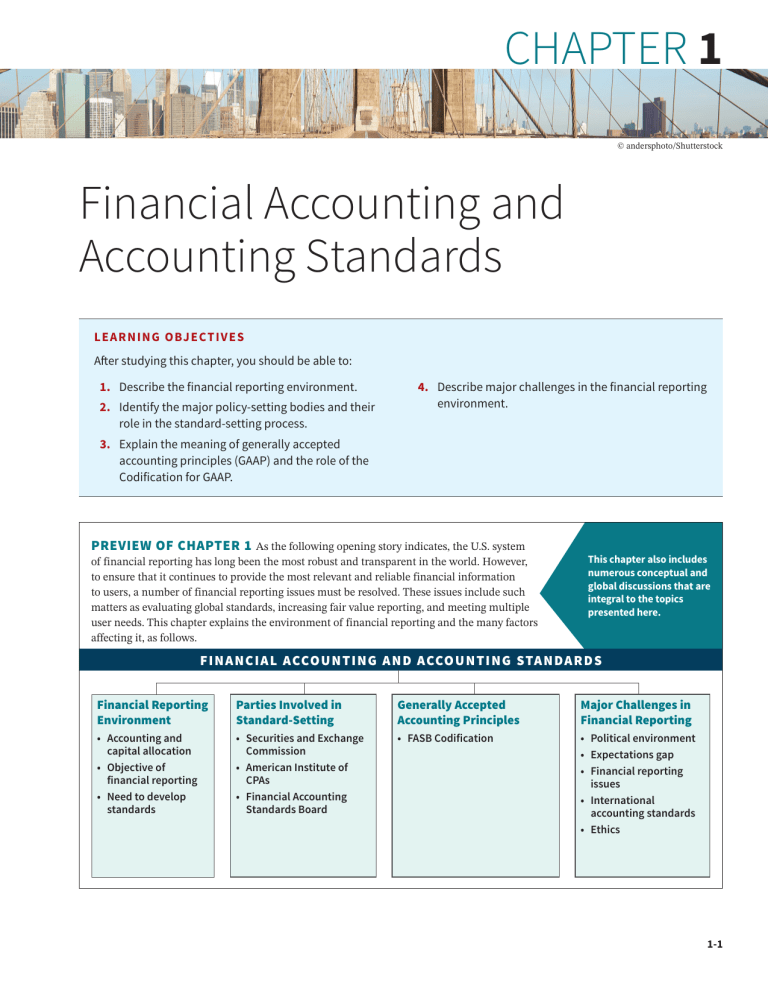
CHAPTER 1 © andersphoto/Shutterstock Financial Accounting and Accounting Standards LEARNING OBJECTIVES After studying this chapter, you should be able to: 1. Describe the financial reporting environment. 2. Identify the major policy-setting bodies and their role in the standard-setting process. 4. Describe major challenges in the financial reporting environment. 3. Explain the meaning of generally accepted accounting principles (GAAP) and the role of the Codification for GAAP. PREVIEW OF CHAPTER 1 As the following opening story indicates, the U.S. system of financial reporting has long been the most robust and transparent in the world. However, to ensure that it continues to provide the most relevant and reliable financial information to users, a number of financial reporting issues must be resolved. These issues include such matters as evaluating global standards, increasing fair value reporting, and meeting multiple user needs. This chapter explains the environment of financial reporting and the many factors affecting it, as follows. This chapter also includes numerous conceptual and global discussions that are integral to the topics presented here. FINANCIAL ACCOU N TI N G A N D ACCOU N TI N G STA N DA RD S Financial Reporting Environment Parties Involved in Standard-Setting Generally Accepted Accounting Principles Major Challenges in Financial Reporting • Accounting and capital allocation • Objective of financial reporting • Need to develop standards • Securities and Exchange Commission • American Institute of CPAs • Financial Accounting Standards Board • FASB Codification • Political environment • Expectations gap • Financial reporting issues • International accounting standards • Ethics 1-1 1-2 CH A PT E R 1 Financial Accounting and Accounting Standards Exciting Times 90% 80 70 60 50 40 0 2007 2008 2009 A recent report says it best: “Accounting information is central to the functioning of international capital markets and to managing small businesses, conducting effective government, understanding business processes, and . . . how economic decisions are made. . . . . Across the globe, a common characteristic of economies that flourish is the presence of reliable accounting information.” Many in the United States take pride in our system of financial reporting as being the most robust and transparent in the world. Yet even with continued improvement in financial reporting over the last 20 years, we have had many accounting scandals occurring at companies like Enron, AIG, WorldCom, and Lehman, as well as the financial crisis of 2008. However, as with many difficulties, there is often a silver lining. As one commentator noted, “Those accounting scandals were a crisis we should be thankful for; Confidence in Capital Markets we got through it and a law was passed (Sarbanes-Oxley Act), and it works.” A key feature of this law is that company executives are required to attest to the accuracy of their companies’ financial statements. To better understand where we are, the Center for Audit Quality conducts a yearly survey that measures investor confidence in such categories as U.S. capital markets, audited financial information, and U.S publicly traded companies. As shown in the chart, the results indicate that the 2008 financial crisis took a bite out of investor confidence. However, investor confidence has rebounded dramatically and is at its highest level since the survey was initiated—perhaps because 2010 2011 2012 2013 2014 2015 2016 2017 of Sarbanes-Oxley. The question now is how can we continue to improve? Here are some possibilities on how we can enhance the existing system of financial reporting. 1. Today, equity securities are broadly held, with approximately half of American households investing in stocks. This presents a challenge—investors have expressed concerns that one-size-fits-all financial reports do not meet the needs of the spectrum of investors who rely on those reports. While many individual investors are more interested in summarized, plain-English reports, market analysts and other investment professionals may desire information at a far more detailed level than is currently provided. Technology may help customize the information that the different types of investors desire. 2. Companies also express concerns with the complexity of the financial reporting system. Companies assert that when preparing financial reports, it is difficult to ensure compliance with the voluminous and complex requirements contained in U.S. GAAP and SEC reporting rules. This is a particularly heavy burden on smaller, non-public companies, which may have fewer resources to comply with the wide range of rules. 3. We also need to consider the broader array of information that investors need to make informed decisions. For example, the percentage of a company’s market value that can be attributed to accounting book value has declined significantly from the days of a bricks-and-mortar economy. Thus, we may want to consider a more comprehensive business reporting model, including both financial and nonfinancial key performance indicators. 4. Finally, we must also consider how to deliver all of this information in a more timely manner. In a world where messages can be sent across the world in a blink of an eye, it is ironic that the analysis of financial information is still subject to many manual processes, resulting in delays, increased costs, and errors. Thus, improving financial reporting involves more than simply trimming or reworking the existing accounting literature. In some cases, major change is already underway. For example: • The FASB and IASB have recently issued less-complex, more-understandable standards in the important areas of revenue recognition, leasing, and financial instruments. Financial Reporting Environment 1-3 • Standard-setters are exploring expanded reporting of key performance indicators, including reports on sustainability and a disclosure framework project to improve the effectiveness of disclosures to clearly communicate the information that is most important to users of financial statements. This project, combined with the introduction of a private-company reporting framework, could go a long way to address one-size-fits-all challenges. • The SEC now requires the delivery of financial reports using eXtensible Business Reporting Language (XBRL). Reporting through XBRL allows timelier reporting via the Internet and allows statement users to transform accounting reports to meet their specific needs. Each of these projects will hopefully support improvements in the quality of financial reporting and increase confidence in U.S. capital markets. Sources: Adapted from The Pathways Commission, “Charting a National Strategy for the Next Generation of Accountants” (AAA, AICPA, July 2012); Conrad W. Hewitt, “Opening Remarks Before the Initial Meeting of the SEC Advisory Committee on Improvements to Financial Reporting,” U.S. Securities and Exchange Commission, Washington, D.C. (August 2, 2007); and Center for Audit Quality, Main Street Investor Survey (September 2017). See the FASB website for updates on FASB/IASB convergence, disclosure, and private company decision-making projects. Review and Practice Go to the Review and Practice section at the end of the chapter for a targeted summary review and practice problem with solution. Multiple-choice questions with annotated solutions as well as additional exercises and practice problem with solutions are also available online. Financial Reporting Environment LEARNING OBJECTIVE 1 Describe the financial reporting environment. The essential characteristics of accounting are (1) the identification, measurement, and communication of financial information about (2) economic entities to (3) interested parties. Financial accounting is the process that culminates in the preparation of financial reports on the enterprise for use by both internal and external parties. Users of these financial reports include investors, creditors, managers, unions, and government agencies. In contrast, managerial accounting is the process of identifying, measuring, analyzing, and communicating financial information needed by management to plan, control, and evaluate a company’s operations. Financial statements are the principal means through which a company communicates its financial information to those outside it. These statements provide a company’s history quantified in money terms. The financial statements most frequently provided are (1) the balance sheet, (2) the income statement, (3) the statement of cash flows, and (4) the statement of owners’ or stockholders’ equity. Note disclosures are an integral part of each financial statement. Some financial information is better provided, or can be provided only, by means of financial reporting other than formal financial statements. Examples include the president’s letter or supplementary schedules in the corporate annual report, prospectuses, reports filed with government agencies, news releases, management’s forecasts, and social or environmental impact statements. Companies may need to provide such information because of authoritative pronouncement, regulatory rule, or custom. Or they may supply it because management wishes to disclose it voluntarily. 1-4 CH A PT E R 1 Financial Accounting and Accounting Standards In this text, we focus on the development of two types of financial information: (1) the basic financial statements and (2) related disclosures. Accounting and Capital Allocation Resources are limited. As a result, people try to conserve them and ensure that they are used effectively. Efficient use of resources often determines whether a business thrives. This fact places a substantial burden on the accounting profession. Accountants must measure performance accurately and fairly on a timely basis, so that the right managers and companies are able to attract investment capital. For example, relevant and reliable financial information allows investors and creditors to compare the income and assets employed by such companies as Nike, McDonald’s, Microsoft, and Berkshire Hathaway. Because these users can assess the relative return and risks associated with investment opportunities, they channel resources more effectively. Illustration 1.1 shows how this process of capital allocation works. ILLUSTRATION 1.1 Capital Allocation Process Financial Reporting Users (present and potential) The financial information a company provides to help users with capital allocation decisions about the company. Investors and creditors use financial reports to make their capital allocation decisions. Capital Allocation The process of determining how and at what cost money is allocated among competing interests. An effective process of capital allocation is critical to a healthy economy. It promotes productivity, encourages innovation, and provides an efficient and liquid market for buying and selling securities and obtaining and granting credit. Unreliable and irrelevant information leads to poor capital allocation, which adversely affects the securities markets. What Do the Numbers Mean? It’s the Accounting “It’s the accounting.” That’s what many investors seem to be saying these days. Even the slightest hint of any accounting irregularity at a company leads to a subsequent pounding of the company’s stock price. For example, the Wall Street Journal has run the following headlines related to accounting and its effects on the economy: • Stocks take a beating as accounting woes spread beyond Enron. • Quarterly reports from IBM and Goldman Sachs sent stocks tumbling. • VeriFone finds accounting issues; stock price cut in half. • Bank of America admits hiding debt. • Facebook, Zynga, Groupon: IPO drops due to accounting, not valuation. It now has become clear that investors must trust the accounting numbers, or they will abandon the market and put their resources elsewhere. With investor uncertainty, the cost of capital increases for companies who need additional resources. In short, relevant and reliable financial information is necessary for markets to be efficient. Objective of Financial Reporting What is the objective (or purpose) of financial reporting? The objective of general-purpose financial reporting is to provide financial information about the reporting entity that is useful to present and potential equity investors, lenders, and other creditors in decisions about providing resources to the entity. Those decisions involve buying, selling, or holding equity and debt instruments, and providing or settling loans and other forms of credit. Information that is decision-useful to capital providers (investors) may also be helpful
